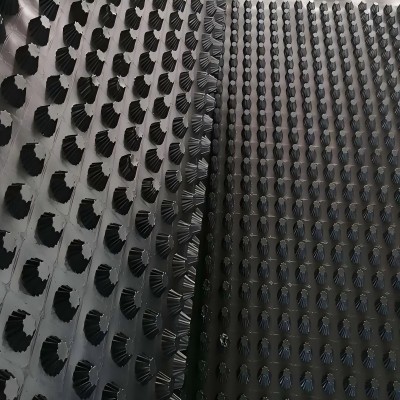1. Basic characteristics of composite drainage board Composite drainage board is composed of one or more layers of non-woven geotextile and one or more layers of three-dimensional synthetic geonet core. It has multiple functions such as drainage, isolation, and protection
1. Compound Drainage plate Basic characteristics of
The composite drain board is composed of one or more layers Non-woven geotextile It is composed of one or more layers of three-dimensional synthetic geonet core, and has multiple functions such as drainage, isolation and protection. Its middle ribs have high rigidity and are arranged longitudinally to form a drainage channel, while the ribs arranged upper and lower cross form a support to prevent geotextile from being embedded in the drainage channel and maintain drainage performance. Composite drainage board also has very good flexibility, high strength, corrosion resistance and aging resistance, and can adapt to various complex geological and environmental conditions.
2. Use classification of composite drainage board
1、Building drainage
In the field of construction, composite drainage boards are mainly used in waterproofing and drainage of basements, roofs, garage roofs and other parts. It can quickly export rainwater, reduce the hydrostatic pressure of the waterproof layer, and achieve the effect of active waterproofing. It can also protect structures and waterproof layers against acid and alkali erosion and plant root thorns in the soil.
2、Municipal engineering drainage
In municipal engineering, composite drainage board can be used in drainage projects such as roads, tunnels, subways, landfills, etc. It can quickly remove groundwater, keep roadbed stable and prevent soil erosion. In tunnel engineering, composite drainage board can also play the role of waterproofing, isolation and protection, ensuring the safety and stability of tunnel structure.
3、Seepage prevention of water conservancy projects
In water conservancy projects, composite drainage board is mainly used in the anti-seepage and drainage of reservoirs, reservoirs, artificial lakes and other water bodies. It can prevent water leakage, keep the water level stable, and also remove accumulated water under the water body to protect the safety of hydraulic structures.
4、Greening project drainage
In greening projects, composite drainage board is often used in garage roof greening, roof garden, vertical greening and other projects. It maintains soil moisture and promotes plant growth, and also prevents plant root rot caused by excess water. It also acts as an isolation and protection, preventing damage to the waterproofing layer by the plant roots.
In addition to the above common uses, composite drainage boards can also be used in special projects such as saline-alkali land improvement and desert control. Its unique drainage performance improves soil environment, promotes plant growth and improves land utilization rate.
3. Selection and application of composite drainage board
1、When choosing a composite drainage board, comprehensive consideration must be made based on specific application scenarios and needs. Attention should be paid to factors such as physical properties, chemical stability, drainage performance and construction convenience of materials. It is also necessary to ensure that the selected materials comply with relevant standards and specifications to ensure the quality of the project.
2、In construction applications, laying and fixing must be carried out in strict accordance with construction specifications and design requirements. Ensure that the composite drainage board is tightly integrated with the surrounding structure to create an effective drainage system. It is also necessary to strengthen quality control and testing during the construction process to ensure that the function of the drainage board is fully exerted.
Post time: Jan-16-2025




